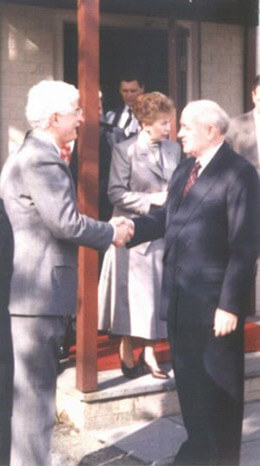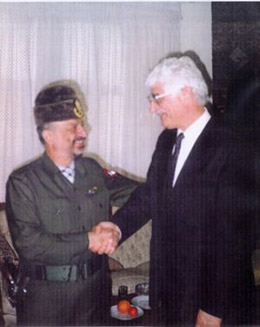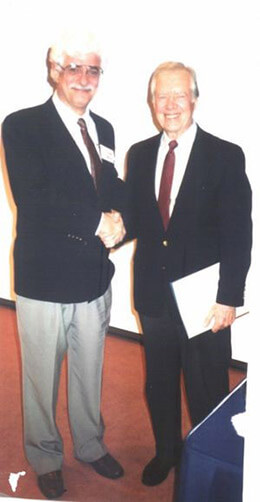|
||||||
| Why do readers of the Library of Social Science Newsletter receive information on book exhibits on the one hand and, on the other, writings on collective forms of violence? This issue of the Newsletter tells the story of how my book exhibit company began at a meeting of the International Society of Political Psychology. | ||||||
My method consisted of presenting Hitler’s ideas through a series of Tables, each containing numerous passages from Hitler’s writings and speeches. Each Table conveyed a central metaphor or theme. These Tables were the centerpiece of my book: the empirical data that allowed me to reconstruct and analyze Hitler’s ideology. In all, my book presented 33 Tables (some containing as many as 40 statements), each given a name, for example: • “The Country is a Living Organism” (Table 1)• “The Disintegration of the National Body” (Table 3) • “The National Body is Diseased” (Table 6) • “Sacrifice” (Table 18) I received my PhD in (experimental) Social Psychology. My supervisors were rigorous empiricists. So—unlike typical historical works that provide a few passages to illustrate a point—I brought forth a multitude of passages. Conceiving myself as a scientist, I provided documentation as proof of my hypotheses. My company, Library of Social Science, came into being when 1000 copies of Hitler’s Ideology were delivered (in 30 cartons) to my small brownstone apartment on 16 West 95th Street (near Central Park West). My business began as I struggled to figure out how to get these books out of my apartment. To make a long (and very arduous) story short, I managed to get copies of the book into the hands of many important scholars—and to make my book a “best seller” in the college library market. In 1976 I wrote a second book, The Psychoanalysis of Racism, Revolution and Nationalism. By this time, I was working out of the Sofia Brothers Warehouse on 83rd Street and Amsterdam Avenue (they moved IBM cartons out of two storage rooms, which I used as my office). In 1977, 2000 copies of Psychoanalysis of Racism were delivered to the warehouse. I began to market the book—much as I had marketed Hitler’s Ideology. But it was selling for $8.95, plus shipping (Hitler’s Ideology sold for $7.95 plus shipping). At these prices, there would be no possibility of staying in business. After selling perhaps 40 copies of Psychoanalysis of Racism, I put the cartons into a storage bin. The “survival phase” (1976-1987) is a story for another time. Let’s fast forward to where I left off describing (in a previous Newsletter on the history of Library of Social Science) how I presented a paper and organized a book exhibit at the 1988 meeting of the International Society of Political Psychology. After 17 years “on my own, a complete unknown”, I “returned” to the academic world. For the next few years, I found a home with the ISPP. Although I hadn’t previously thought of myself as a political psychologist, this was a decent description of what I was doing. In addition to my presentation and exhibit, several other good things happened in relationship to the ISPP in 1998. Psychoanalysis of Racism (finally published in 1986 after nine years in the storage bin) was released, and received a very positive, five-page review in the ISPP’s journal, Political Psychology. In another 1988 issue of the journal, I wrote a review of Howard Stein’s book, Developmental Time, Culture Space (1987). Building on Hitler’s Ideology, Stein invented the concept of “psychogeography.” It was an article published on the ISPP in a 1989 issue of Newsweek, however, that changed my thinking about the meaning and purpose of my work. My identity was primarily that of a scientist applying a rigorous, empirical methodology to the study of political ideology. I’d never been actively involved in politics, and certainly didn’t think of myself as an “activist”. The Newsweek article (by David Gelman) was entitled “Why we all love to hate: Political psychologists bring hostile national groups together to explore the need for enemies.” Summarizing the work of several researchers, the article stated that having enemies “fulfills an important human need.” Psychologists say that nothing promotes cohesion among social, ethnic or national groups as surely as a “common object of loathing.” The Newsweek article cites Howard Stein asserting that there is “no ‘us’ without there being a corresponding ‘them’ to oppose.” Stein, Gelman explains, is one of the scholars contributing to the “enterprising young field of political psychology,” which tries to “apply the insights about individual and collective behavior to the geopolitical field.” Gelman quotes Dr. Vamik Volkan (President of the ISPP, 1983-1984)—whose 1988 book The Need to Have Enemies and Allies had just been published: “A psychological process goes on in international relations, and at the bottom of it lies this need to have enemies in our lives. We are trying to understand it.” Volkan had been participating in a series of meetings dubbed “Track Two Diplomacy,” a kind of international group therapy whose purpose—according to career Foreign Service officer and State Department official Joseph Montville—was to “establish ‘networking’ contacts between hostile groups.” Volkan and Montville were involved in a series of seminars between Egyptians and Israelis, and between the US and Soviets. According to the Newsweek article, there were signs that some of the ideas generated by these meeting were “registering in high places.” When Anwar Sadat asserted in a 1977 speech to the Israeli Knesset that the problems between the two nations were “70 percent psychological,” it sounded as if he had been tuning in to some of the meetings (indeed, one of the drafters of the Knesset speech had been a Track Two participant). When, Gelman says, “more astonishingly,” Soviet leader Mikhail Gorbachev in a Kremlin speech welcoming Ronald Reagan hailed the overthrow of “habitual stereotypes stemming from enemy images,” political psychologists felt certain their dialogues were “paying off bigger then they dared hope.” The whole idea that enmity is a psychological concept, according to Montville, had “worked its way in important ways into Gorbachev’s speeches.” So there it was in this Newsweek article: the idea or possibility that psychology could “change the world;” indeed, that political psychology already had helped to change the world. As a (social) scientist, one’s primary objective is to identify “systematic relationships between variables”. Here, however, was a suggestion that my research and findings might be useful. I met and spoke with Joseph Montville at the 1988 ISPP meeting, and sold him copies of my books. We later corresponded (I was impressed with the “State Department” stationery). I began an ongoing relationship with Vamik Volkan, whom I frequently met at conferences where he was keynote speaker (the photo below was taken at a boat-ride that Denis Snook put together for the 1992 ISPP meeting in San Francisco).
Why am I writing this piece on the history of Library of Social Science? Because I’m trying to unite—or re-unite—two dimensions of my business that, perhaps, became separated. Those who get the LSS newsletter (publishing professionals, as well as scholars) receive information on our book exhibits, as well as essays and articles on the causes and meanings of collective forms of violence. What is the relationship between book exhibits and analysis of violence? Why do these things go together? One can understand this relationship by going back to the origin of the book exhibit company in 1998—and my relationship to the International Society of Political Psychology. The aspiration to create a book exhibit—and to understand the meaning of collective forms of violence through political psychology—were one and the same at this foundational moment. To this day, there is no separation between my business aspiration (the desire to grow my book exhibit company) and my role as a scholar who aspires to change the course of history by using psychology to comprehend collective forms of violence. To be honest, when I read the Newsweek article on Vamik Volkan and other political psychologists’ impact—I didn’t entirely believe it. It seemed a bit of a fantasy until I came across of photos on the Web (reproduced above) of Volkan with Gorbachev, Yasser Arafat and Jimmy Carter—and learned that he’d been nominated four times (2005-2008) for the Nobel Peace Prize. |



